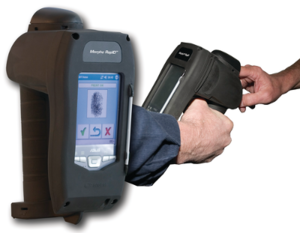Law enforcement technologyWireless fingerprint readers help police fight crime
Using a new wireless device, police across the country are now able to quickly and accurately identify a suspect in the field; using RapID, a small handheld unit, officers can read a suspect’s fingerprint and check it against a database for any matches; if any matches are found the device will pull up the person’s real name, date of birth, gender, and race, making it more difficult for criminals to use a false identity

RapID enables identification in the field // Source: officer.com
Using a new wireless device, police across the country are now able to quickly and accurately identify a suspect in the field.
Starting in 2006, the Columbus police department has used RapID, a small handheld unit that can read a suspect’s fingerprint and check it against a database for any matches. If any matches are found the device will pull up the person’s real name, date of birth, gender, and race, making it more difficult for criminals to use a false identity. This also eliminates the need for officers to return to the station and submit the fingerprints for a scan which can take hours. Most recently law enforcement officials in Wake County, North Carolina acquired the wireless fingerprint readers making it the first county in the state with such capabilities.
“By using this equipment, officers can more readily identify people during an officer-subject encounter, at a crime scene investigation or while serving a warrant,” said Sam Pennica, the Director of Wake County’s City County Bureau of Identification. “This partnership will allow law enforcement agencies to complete their jobs in a more effective and efficient manner.”
The devices are manufactured by Washington based SagemMorpho Inc. and cost about $3,000 each in addition to wireless contracts that cost $20 per month.
